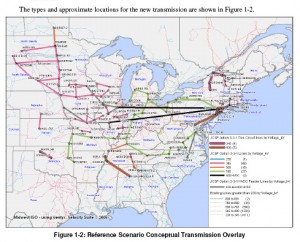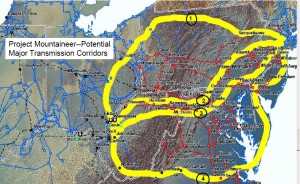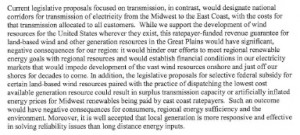Offshore transmission, NOT transmission from Midwest
December 6th, 2009
By standing up for offshore transmission for wind, Delaware’s Gov. Jack Markell stands up to Midwest coal!
The Mid-Atlantic states have been standing up and opposing transmission from the Midwest. They’ve gone on record in a number of venues, and in their opposition are citing Midwest transmission promoters’ disregard for eastern renewable efforts, that xmsn may well not be an economical way to get power to the east, and that THEY KNOW THAT MIDWEST TRANSMISSION PLANS INHERENTLY ARE ABOUT COAL. The plan they’re referring to is a massive transmission buildout known as JCSP, and it also applies to the big PJM buildout that includes the PA-NJ Susquehanna-Roseland transmission line that was the subject of a hearing last month.
Here’s JCSP (Joint Coordinated System Plan) note their site now talks about wind — but look where the transmission starts, DUH! The coal fields of the Dakotas:
Gotta give them, Delaware, Maryland and Virginia, a lot of credit for recognizing and stating what Midwest states have been unwilling to admit.
That said, here’s what Mid-Atlantic states are doing — they’re banding together to propose offshore transmission. If it’s underwater offshore transmission, that’s an idea that’s hard not to like. But I’ll bet it throws PJM for a loop, what with all their “backbone” transmission schemes, a la Project Mountaineer, that are in the works:
The FERC birth of Project Mountaineer:
And you can see that those lines in play now, PJM’s “backbone” transmission projects like Susquehanna-Roseland (NE part of Project Mountaineer Line 1) and MAPP (NE part of Project Mountaineer Line 4) are part of the plan… the big transmission plan that does not work for the east coast.
Here’s the Memorandum of Understanding between Delaware, Maryland and Virginia:
And recently, Gov. Jack Markell addressed these issues before American Wind Energy Association’s offshore windfest — but given the PJM big-transmission-projects-from-hell are referred to as “backbone” projects, I wish they’d find another term:
Delaware energy: ‘Backbone’ power line pushed for wind farms
By AARON NATHANS
The News JournalGov. Jack Markell broached the subject this week in his address to the American Wind Energy Association’s offshore wind workshop, the industry event of the year on this side of the Atlantic. Markell signed onto letters the governors sent to members of Congress this summer, and the Federal Energy Regulatory Commission last month.
“Let’s have the conversation,” O’Mara said. “It’s extremely worthy of further study.”
“It obviously won’t happen in the absence of federal leadership,” he said.
Fishermen’s Energy President Daniel Cohen said it’s a good idea, but “it’s another moving part.”
The benefits of building lines transmitting wind power from the Midwest are less certain, he said.
“It will be difficult to get progress in this area until there are clear national goals,” he said.
Note that “cost allocation” is raised. Since the 7th Circuit decision tossing out FERC approval of PJM’s transmission cost allocation dream/nightmare, all transmission projects 500kV and over based on that cost allocation scheme are in limbo.
So as noted, who pays, and submarine transmission is EXPENSIVE, is THE big issue now. It’s the big issue for land transmission, it’s the big issue for offshore transmission, and, given the uncertainty since the 7th Circuit decision, maybe some of the sturm and drang could be circumvented if it’s designed at 345kV or below, and uses the “benefactor pays” theory. We shall see…
Eastern Governors stand up against Transmission!!!
May 6th, 2009
Yeaaaaaaaaaaaa! One for the home team!!!!
First it was NYISO and ISO-New England:
Then it was New York’s Deputy Secretary of Energy testifying before Senate Energy Committee:
And now the Governors from the Northeast and Mid-Atlantic states have stood up against the insane Midwest transmission plans — transmission plans like CapX 2020, JCSP/MTEP, Green Power Express, and the unnamed group announced on April 3rd, starting in North Dakota, banding southern Minnesota, and shooting out into Wisconsin.
Here’s their letter:
It’s blurry, so click the letter and read the whole thing. An eye opener for the Midwest, those who don’t recognize that there’s a big world out there and it’s not all about Midwest wind. Folks, you have a marketing problem, your target market says NO! What about NO can’t you understand?
FERC Order re: Green Power Express transmission
April 12th, 2009
A little over a month ago, ITC Holdings filed a rate request with FERC, and utilities in the Midwest got to it and filed “protests” and petitions to intervene in that docket. FERC had extended the Comment period until March 6, and oh, did they get comments. The Who’s Who of utilities, with big emphasis on the Midwest, “our friends” at Xcel represented in a number of capacities… and even National Wind and Goodhue Wind!
A little birdie dropped off a notice that FERC had issued an Order:
I’ve just skimmed it so far, but it looks like they pretty much gave Green Power Express (a/k/a ITC Holdings) the whole enchilada… what they’re asking for is the ability to recover $$$ before the line is even energized, which is absurd, but that’s what all these utiltiies have been asking for and getting, so it’s not really anything new. Theh difference, it appears, is that ITC is pushing into Xcel’s transmission territory, and Xcel isn’t too happy about it. The Green Power Express is essentially the Midwest part of JCSP and METP 08, but maybe there’s … ahem… a little confusion about just who was going to build that transmission?!?!? FERC accepted responses of GPE to Comments, and accepted a response of MISO to comments (in which MISO is siding with GPE), but they rejected all the others, like Xcel, GRE, etc., the ones opposing GPE. Xcel’s probably not used to getting dissed!
I’m really not sure what to think about this. The project shouldn’t be built, it’s not needed, that’s for sure, and they shouldn’t get rate recovery, that’s also for sure, but I’ve got to give them a few points for butting in on Xcel’s action.
… and now I’ve finally read the whole thing, and it redefines “Shock and Awe” — this FERC Order gives them 99% of what they asked for, and seemed to bend over in doing so, doing everything they can to give Green Power Express the green light, and to start collecting $$$ right away. So we’ll be paying for this, and even if it’s not built, we’ll be paying for it. This transmission binge is reminding me of the nuclear days of the 70s, and we are going to get hit so hard. What are these yahoos thinking?
What next? Well, I hope that Illinois and New York will get to it and let FERC and Green Power Experss that “WE DON’T NEED NO STINKIN’ TRANSMISSION!” New York has been doing a good job thus far giving JCSP the finger, and I hope they continue, because this, logically, will have coal on the wires and will facilitate construction of new coal plants in the Midwest.
Hmmmm… my brain just did a “frolic & detour” — “Coal on the Conductors” just popped in …
Going into the CapX hearing with all this transmission lining up… (she says, shaking her head in disgust)
Comments – FERC docket on Green Power Express
February 28th, 2009
A little birdie told me that the Comment period on the Green Power Express rate docket at FERC has been extended to March 6, a week from now.
To find the FERC docket (maybe there’s a quicker way, but this is all I know so far…), CLICK HERE and search for docket ER09-681.
The filing is just too big to upload, but you can see the redacted version here:
What they’re wanting to do is stick their Construction Work In Progress (CWIP) into the rate base… they want to be able to charge us for this, for putting this together!?!?! “Who” is the rate base in this, what are the costs, at what point could they be assessed?
I’m struggling to wrap my pea brain around this, but I’m wondering what the difference is between this and what Xcel got in the 2005 Transmission Omnibus Bill from Hell, other than a much wider rate base:
The rate base that ITC Holdings could spread this over is immense, as opposed to Minnesota’s utilities’ rate base, and the idea of paying for development of this phenomenally stupid idea just galls me… but I’ve got some reading and thinking to do here. Intervenors are lining up to weigh in and fight about it.
And then there’s that 7,000MW of wind in the MISO queue in Illinois, and it’s the Chicago transfer numbers they want to keep secret. Shouldn’t someone tell them that there’s all that wind in Illinois?
I’m printing out this sucker for a winter night’s read…
Check it out — what do you think?
Denial is NOT withholding… Piedmont v. FERC
February 18th, 2009
EEEEEEEEEEE-HA!
OH HAPPY DAY!!!!
A victory for states’ rights, for state decision-making authority and jurisdiction over transmission lines. The National Interest Electric Transmission Corridor designation has been horrifying to many of us because the talk on the street was that the rules allowed transfer to FERC where a state was “withholding” granting a permit. That was being interpreted as broadly as a state denial — that if a state reasonably denied a permit for transmission, the applicant could then take it to FERC and get it rammed through. So it went to court…
AND THE COURT SAID NO!
NO!
Like wow…
It’s printing now, and I’ll find some choice snippets. This is such a relief, but I doubt the utilities will let this go unchallenged — onward and upward!








